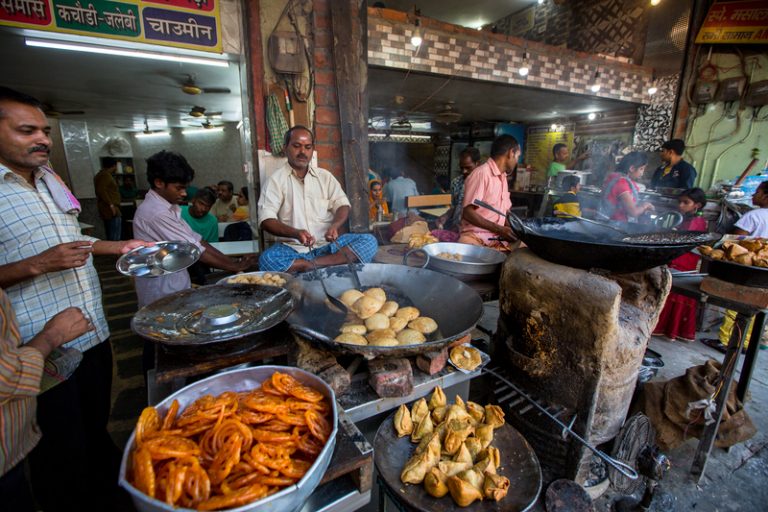Indian street food differs significantly between regions and even between vendors within regions. The country’s street food leads you to something fresh and wonderful to delight your eyes and taste buds, from puchkas to kathi rolls to paan and jalebi. Want to learn more about Indian street food and how it influenced the locals’ tolerance for spice? Then continue reading!
The vibrant culinary culture of Indian street food
Street food is scarce in some countries. In India, this is not the case. The variety and abundance of Indian street food rivals that of Indian cuisine. Every region has its specialty, with city vendors offering hundreds, if not thousands, of distinct selections.
The roots of street cuisine in India are unknown. However, it is usually assumed that they date back to when Mughal ruler Shah Jahan relocated his capital from Agra to Delhi. During that period, the most popular Indian street cuisine, chaat, was introduced to Old Delhi. After Mughal officials invited cooks from Varanasi to open a shop in Delhi, it became famous as a midday snack.
Today, street food is an integral aspect of Indian culture and has spread throughout the country. Its low cost allows it to be accessible to everyone. Dosa, kebabs, biryani, korma, and kulfi are other Indian street food delicacies besides chaat.

Digestive adaptations: A matter of acclimatization
Spicy foods contain capsaicin, which stimulates a TRPV1 receptor in your mouth and tongue. The number of receptors each human carries varies from person to person, which is why some individuals can and cannot tolerate a little spice in their lives.
According to studies on spice tolerance, prolonged consumption of capsaicin could be attributable to the fact that the more you eat spicy food, the more your body can withstand it. This is particularly so in nations and cultures where spicy cuisine, such as India, is a staple regional diet. If you’ve grown up consuming spicy food, you’ve most certainly developed a tolerance.
Additional research has found that there is typically a psychological component at work while eating spicy foods. Spice enthusiasts experience burning and sometimes agony when eating their favorite curry, but many find it delightful rather than painful.
Hygiene concerns: A clash of culinary norms
First, a lack of fundamental infrastructure in the regions where they conduct business, such as clean water, adequate food waste disposal, and electricity, hinders their capacity to implement their learnings about food safety and hygiene. Second, many vendors have little incentive to manufacture safer foods because the enhanced quality would be difficult to notice in practice, and hence, consumers would not reward them.
Third, customers in this market may not have a high enough demand for sanitary food. Because of the norms in India, many value food safety and are prepared to pay extra for it. However, the majority are unable to discern between safe and infected food. Many people have other considerations, such as the retailer’s variety of products.
India’s initiative for safe street food
In July 2017, the Food Safety and Standards Authority of India (FSSAI) launched India’s largest Food Safety Training & Certification (FoSTaC) program. This was to develop a pool of food safety supervisors (FSS). During the first five years following the FoSTaC’s inception, 950,000 above FSS were trained in over 32,000 training nationwide.
Forming such a vast training capacity demonstrates that the country is going through a significant transformation in food safety. FoSTaC training is designed to instill a culture of self-compliance with food safety procedures among food businesses. This is mainly for street food sellers and to raise the bar for food safety and cleanliness in the country.
Tips for foreigners who want to try Indian street food
As previously stated, Indian street cuisine is inexpensive, delicious, and colorful. It tastes far superior to traditional takeout or sit-down eateries. This is because Indian street food is prepared in front of you with fresh ingredients. Don’t be swayed by misguided people’s rants; test them out for yourself. Here are a few things to remember to enjoy Indian street food to the utmost!

Messy floors and tables are not ominous signs
Travelers would think seeing used napkins, silverware, and empty dishes strewn about a stand was a negative sign. This is not always the case, which may suggest the vendor has been extremely busy. Don’t let this dissuade you since some people will clean up your table as quickly as possible.
Keep an eye on the spice level
Consuming spicy food if you’re not used to it isn’t the same as getting food poisoning, but it can make you feel ill. Food in India might be another layer of what you consider “hot.” Even if you enjoy spicy foods at home, starting with low or medium spice levels until you know what to anticipate is recommended.
Be mindful of your allergies
Eating street food in India is especially difficult if you have allergies or other dietary limitations. Look online before you go to the food stalls to discover if anything you can’t eat occurs in everyday dishes. Of course, not every vendor follows the same formula, but it will give you an idea of which meals you should avoid.
Celebrating cultural diversity through India’s street food
Some people may attempt to avoid Indian roadside stalls because they are concerned about hygiene. But Indian street dishes are far more nutritious, flavorful, and freshly prepared.
Street vendors in India make a living from their stalls, so they will always try to please their clients so that they will return. As a result, they ensure that the food is not only excellent, but also fresh and hygienic.
Follow us on X, Facebook, or Pinterest

